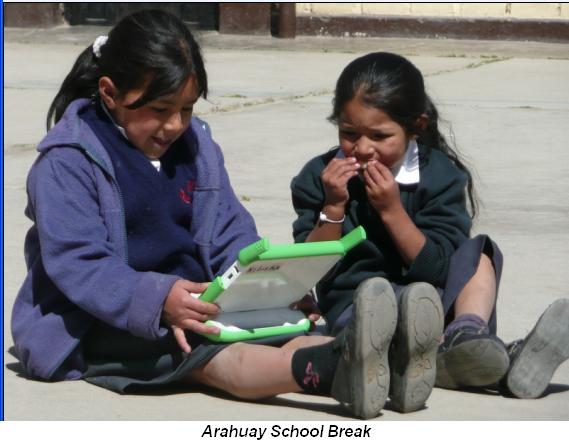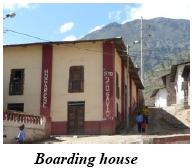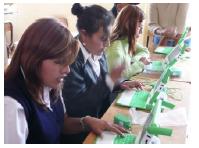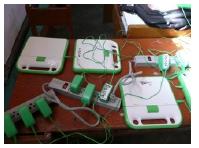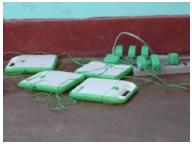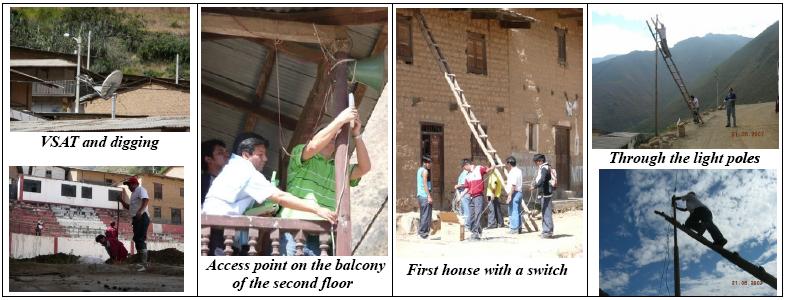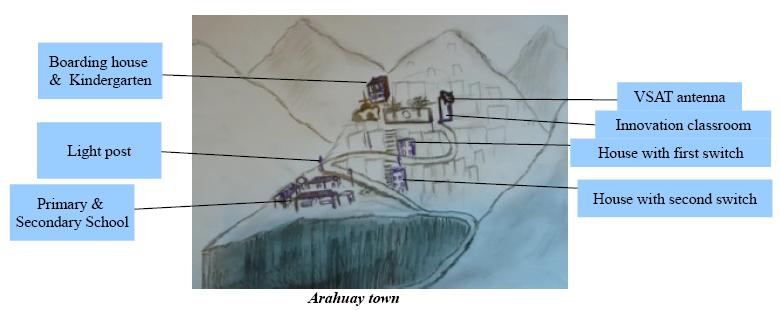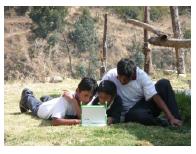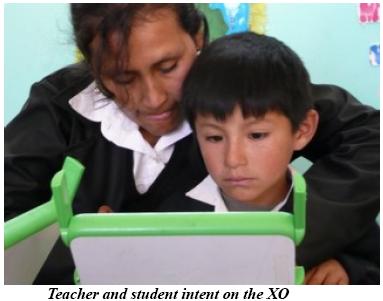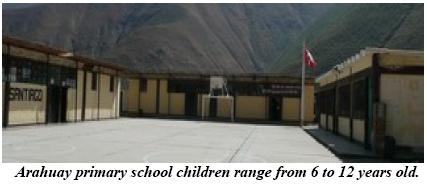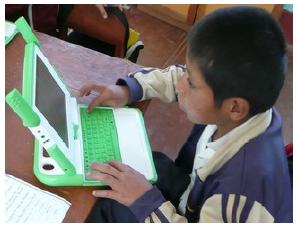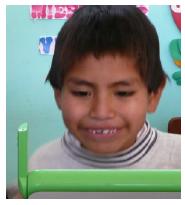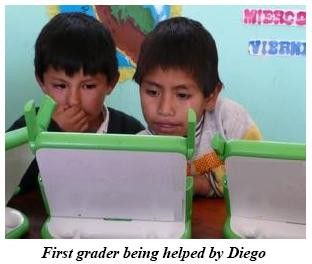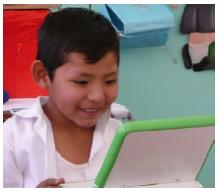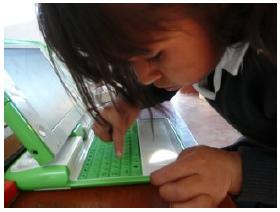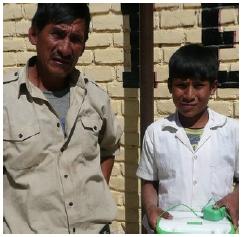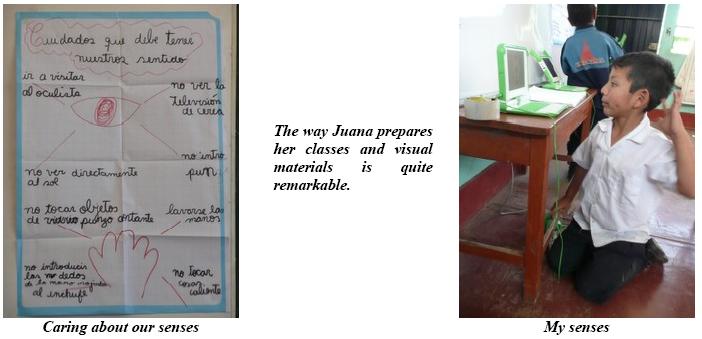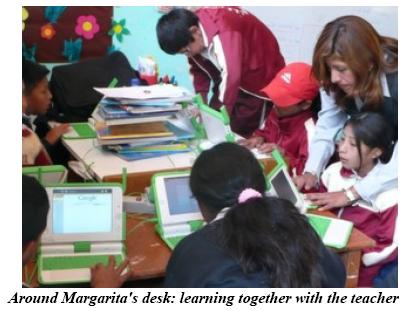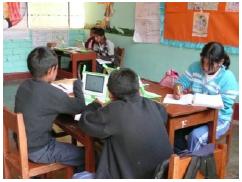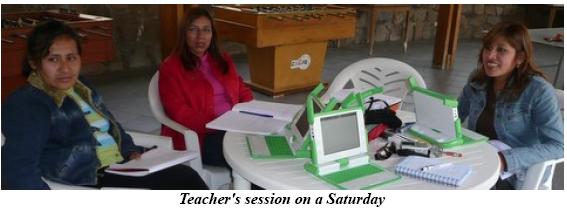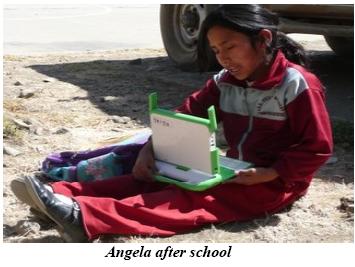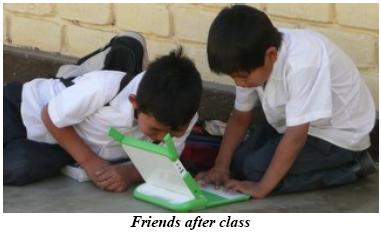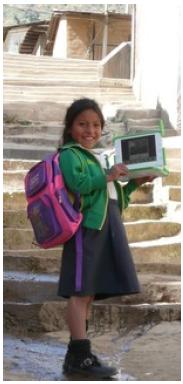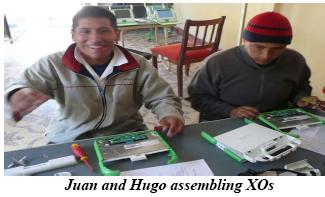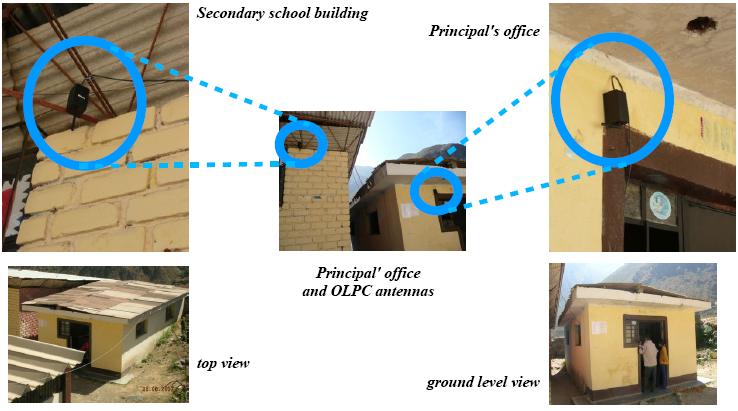OLPC Peru/Arahuay
Translate this page with Google -español -български -中文(中国大陆) -中文(臺灣) -hrvatski -čeština -dansk -Nederlands -suomi -français -Deutsch -Ελληνικά -हिन्दी -italiano -日本語 -한국어 -norsk -polski -português -română -русский -svenska
Ulaanbaatar.mn | Arahuay.pe | Khairat.in | Ban Samkha.th | Galadima.ng | Cardal and CEIBAL.uy | Bashuki.np | Bishwamitra.np | Atlas School.pk | Altos de Cazucá.co [+/-]
Arahuay is the town were the first Perú's pilot is being implemented. Arahuay at elcomercio.com.pe. Location of Arahuay in Google Maps, just beyond hi-res availability. See also: OLPC_Peru/Revisits
Arahuay video
School : Institución Educativa Apóstol Santiago : Escuela Since : 2007-07-07 : Desde Students : 46 : Estudiantes Teachers : 3 : Docentes Laptops : 60 : Laptops Tot.Pop. : 742 : Pob.Tot. Feature : 2600 m (alt) : Característica
Chronicle 1
Text and photos by Carla Gomez Monroy, OLPC
OLPC in Peru: 16 – 30 June 2007
[editorial note: the teachers' and students' names are fictitious.]
Arahuay
Arahuay is located in the Cordillera de la Viuda at 2600 meters above sea level, where mobile phone signals are only available in the mountains that have special antennas.
It's not far from Lima, approximately 100 km away and about a 3-hour drive, of which 37 km are on a dirt road, which takes one hour or more, depending on the time of day and night. Transportation is limited to two buses during the day. One leaves Arahuay at 6 AM and the other at 3 PM. On their way back, the bus arrives in Araguay at 11.30 AM and 7 PM.
Arahuay is an agricultural and animal farming town of around 500 people. Education has become an important factor for the development of their children. Every child in town must attend school. The name of the school is I.E. Apóstol Santiago and it is a combination of primary and secondary school. I.E. stands for Institución Educativa, which translated is Educational Institution.
Primary school is a multi-grade school. 1st and 2nd grades are taught together by one teacher, A. And 3rd and 4th grades are taught by B, while 5th and 6th are taught by C. Secondary education is 5 years long, and the school has 4 secondary classrooms. The primary school has 46 students, 8 in first and second grades, 21 in third and fourth, and 17 in fifth and sixth. Secondary school has around 50 more students.
Education for all
Some students come from other towns and even from Lima, the Capital of Peru, to study in Arahuay. The town of Arahuay provides them with a boarding house during the week. The boarding house is the former primary school and it has a kindergarten in it. Meals are sponsored by the Nutrition Aid National Program (PRONAA). The CARITAS Catholic Association takes care of the children at the boarding house, and the cook is paid by the Parents Association. Children arrive on Sunday night in Arahuay and leave Friday afternoon, bound for their hometowns. Some of these children have to walk 5 hours to get home, and 5 hours back.
This boarding house arrangement is uncommon in Peru, so this local effort is an outstanding initiative. The boarding house is for girls and boys, which makes it more interesting, since traditionally girls are not allowed to be away from home.
The Huascarán Program
The Ministry of Education has the Huascarán Program, which promotes the application of Information and Communication Technologies to 3260 state schools in rural and marginalized urban areas in Peru. Including the alternative basic education system (for adults), special education (for handicapped children), and bilingual schools (a community’s mother-tongue and Spanish).
The Huascarán Program provides two kinds of services, depending on the geographic location and the local needs of the schools. 1) They provide teachers and principals with guidance on pedagogical aspects and on the application of ICT to their learning activities. 2) Also, in some places, Huascarán Program provides them with an Innovation classroom, which has about 5 to10 PCs, depending on the number of students. In some cases, Huascarán Program also provides them with a VSAT antenna when the cabled signal is not available. And the local person in charge of the classroom is trained technologically and pedagogically.
Huascarán Program in Arahuay
Arahuay town's Local Education Facilitation Unit (Unidad de gestion educativa local) provided 5 PCs, and Huascarán Program contributed with the VSAT, its installation, and the server configuration for the Internet. The Innovation classroom and the VSAT are in the town hall, which is halfway up the hill. The decision of setting up the Innovation classroom in the first floor of the town hall was for security reasons. The school is at the lowest part of the town.
Information dissemination
Information in towns like Arahuay and its surroundings spreads by word of mouth fast. Even the first day we came to town, just to look-see and to come back prepared, as well as to speak with the principal and teachers, when the afternoon bus came and a man got off, he asked the principal about the laptops. We just laughed.
Handing out the laptops
The teachers first encounter
The three primary female teachers live in town during weekdays, and Friday afternoon they go to Lima to visit their children and family. Sunday evening, they come back to town. B, one of them, has been teaching for 8 years in Arahuay already.
When we came to introduce the OLPC Project to their school, they weren’t expecting us. Nevertheless, they were interested in the idea of working with us in the afternoons when they were in town. In June, there are 4 holidays which take place precisely during our implementation period. Since they leave town right after school on Fridays, we proposed working with them Fridays in the afternoon and one Saturday to take advantage of the little time the team was going to be in Arahuay. At first, they were enthusiastic about the schedule. However, every day that they work with the laptops, they become more acquainted with them and enjoy the teacher sessions increasingly.
The first time we came, we came for just one day. It was a Monday. We introduced the teachers to the project, and we had our first session with them. Since then, they kept their laptops. Due to procedural Ministry of Education reasons, we could not come back to town right after to start working with everybody everyday. However, we did come back the following Thursday to apply the evaluation tests and run the information and perspective surveys that had been prepared by the Huascarán Program Pedagogical Team, comprised of D and E, and by the Measurement of Quality Unit. That afternoon we worked with the teachers, and in the evening, we handed out the laptops to the parents and their children in a special meeting we held with them for the purpose.
Children receiving their laptops
Thursday evening, we had set the meeting at 6 PM when parents start getting back from their chacras (where they farm). We started at 6.30, when more parents were around. The principal welcomed the OLPC in Peru team and spoke of how honored the town was to be the first one to receive the laptops and to participate in the development of the project in Peru. After him, the president of the parents association spoke, also welcoming us. Representing the Ministry of Education, D spoke, explaining the purpose and details of the project. I spoke about the OLPC Project and the importance of making it a community project.
We handed out the laptops following the school lists. Each child came to the front with his or her representative to receive an XO laptop and to have a photo taken. Everybody was very excited, though to my surprise, none of the children opened their laptop.
The parents had cooked for the OLPC-Peru team a traditional pachamanca (goat meat cooked under ground), which we enjoyed a lot. Bringing back some of such delicious food to all the wonderful OLPC people in the world is impossible. But I can share the handmade posters they set up in the classroom where the ceremony took place... They were made for all of us:
We left town too late and had to drive really slowly in the dangerous and super dark way back to the next town where we are staying. On the way, I asked why nobody had opened their laptop during the ceremony,...and I was told that out of respect to their parents. I was quite surprised, but looking forward to seeing the children’s reactions the following day at school.
The parents
Something the teachers told us afterwards, that also impressed us, was that every single parent came to the meeting, except for two of them, even when parents had to walk incredibly long distances to make it. Of the parents that didn’t show, three children are brothers who are fully registered in the school, and we also gave them their laptops. They will be able to use their laptops freely, as all the other children in Arahuay town, however, they will not be able to take their laptops back home on weekends until their parents come and approve that it's okay for them to take them home on weekends. Town authorities and OLPC-in-Peru are concerned that since they go so far, they may be hurt by someone trying to steal their laptops from them, since word has spread that they have laptops. Nevertheless, the Arahuay community has committed itself to making sure the children can freely and securely use their laptops around town.
A new student at school was transferred two weeks ago but had not been registered yet. Her father came, walking many hours, the day after the ceremony to finally register her daughter in the school, so she could also receive her laptop. For her own safety, she will not be able to take it with her on weekends.
The XOs' first day at Arahuay school
Early morning on Friday, all children were in their classrooms with their laptops charged. Most of them had already tried it at night, and it was a mix of discovering new things and sharing with others what they had already discovered. Teachers kept on teaching, letting children explore their new laptops and encouraging them to do the class work. The children did all the activities. Some would put away the laptop while writing on the notebooks. Some others would write quickly on the notebook and then start punching here and there on the laptop. Still others were totally into the laptop and so excited that they would be doing something totally unrelated to the class and calling the teacher to come and see what they had discovered.
Since most of them had tried it at night and also during the morning, the batteries started running down, and everybody wanted to plug and charge theirs. So some moved closer to the outlets and started working from there. A student in grade 3-4 stood up and unintentionally pulled the charger cable, and his laptop fell down. He was really worried that it was not going to work any more. In fact the keyboard stopped working and he was really concerned about it. I was called out from another classroom to come and see it. I went in and then out of the classroom with the child and his laptop, telling him that we were going to fix it. He kept on asking when he would have it back. We sat in the garden, and I helped him get it open, and we quickly fixed the keyboard. Some of the secondary students stopped by to look, and they found it interesting. When we were going to start it, he was still worried that it was not going to work anymore. Once it started, and when the keyboard was actually working nicely again, he was so happy.
On the first day, we also discovered that children started punching all the keys as soon as the laptop starts. And on that first day we had four laptops that were all confused for being typed on while the OS was booting. One worked after simply being re-started, though three of them had to have their NAND re-installed.
On the technical side
Electricity, charging, alternative powering solutions
Plugging in the laptops is an issue that has to be looked into soon. The school electricity set up is for handling only one light bulb per room, so having many laptops charging at the same time is not safe. Also, because all the children want to plug in their laptops at the same time. We are encouraging them to bring their laptops fully charged from home, though the battery takes too long to get fully charged and around 2 to 3 hours to get discharged.
Children found that the chargers get too hot for them, so they have been instructed to turn off the power strip before placing or removing their charger.
We have two children with no power at home, so they will be given preference, charging their laptops early morning and before leaving school.
Today, July 1st, I was told that the Ministry of Education authorized moving the Innovation classroom into the principal's office, appropriately wired. The school and the parents probably will have to look into the wiring of the classrooms. I have requested some solar panels to make the battery charging safer for children.
Network configuration
When the OLPC servers and access points had not arrived in town, the configuration was as follows. There was a server providing connectivity to the 4 PCs that are in the Innovation classroom. An access point was placed on the outside balcony of the second floor, from where the school can be seen. The existing wireless access goes from that access point to part of the school, including the houses in the way, the patio of the school, and the 5 & 6 grade classroom.
A wired connection was run through town, in a straight line from the access point at the top, setting two switches in two different houses along the way. Another access point was placed in the principal's office, giving a strong wireless signal to the entire school.
- (the last column of photos was taken by Eduardo)
The physical distribution of the network connectivity in Arahuay is unusual, and it was not considered by the OLPC server developers, however the technical team is putting in a lot of effort to provide the strongest signal possible to the school and nearby places. I made a little painting of the Arahuay setting.
The secondary students
The secondary students had made comments that the laptops should not be given to the primary students because "they don't know how to use laptops." However, they have been very keen and helpful running the cable through town, climbing high up on the light posts, house roofs, and all along the way, helping with the wiring. They also helped, together with the assistant teacher, to dig the hole to ground the VSAT antenna (which means a 1 meter deep and a 3 meter long dig) behind the Innovation classroom. Some of them are also interested in learning how to fix the XOs or learning how to work with them in case something goes wrong, to aid the primary students. Secondary students that have siblings in primary school borrowed their XOs to play with them and to access the Internet.
Chronicle 2
Carla Gomez Monroy, OLPC
OLPC in Peru: 21 June – 10 July 2007
Introduction
When I'm asked how we are measuring the benefits for children of the OLPC Educational Project and what kind of parameters and evaluation methods we are using, it is hard for me to figure out what people really expect to hear: That the moment children got their laptop they became smarter? That at the end of the period between moment x and moment y, the children in the laptop group performed better than those in the placebo and the no-treatment groups? Well, in Arahuay School the Peru Ministry of Education is running a short term pre-test and post-test pilot study, with an OLPC group only, to see what light can be obtained regarding what actually happens and how it happens in terms of knowledge, performance, and skill development variables. We are going to have the fully analyzed data and results by the end of November.
Meanwhile, many events, which may or may not have made children smarter, are worth highlighting. The OLPC project gave place to an environment, created by and for the child, which fostered learning in a more motivating and significant way than had previously been the case. I present a few observations regarding some people, events, and experiences of the month we spent in Arahuay implementing the project. They have to do with personal motivation, inter-personal relationships, and community impact, with a positive influence on the children, teachers, school, and the whole community, as well as on us, the implementing team.
Observable changes
In general
Right after the project started, we noticed that most of the children started coming to school tidier or better dressed, no one commenting on it.
In the three different classrooms, several children showed aggressive behavior towards their classmates, absenteeism, and even desertion. The teachers made these observations and pointed out specific children who had changed their behavior patterns tremendously. I have to make a note regarding some of these children. It is obvious that each child has a world of its own, but at Arahuay School most of the children are lacking in good nutrition, clothes, and housing, and some don't even have a family to give them care, affection, and love. Some children who were lacking in family support at least came back to school by themselves.
Impact on behavior: Antonio and his brothers
Antonio is about 8 years old and is in 2nd grade because he is repeating it. He has a twin brother, Bernardo, who made it to 3rd grade, and another brother, Clemente, who is in 6th grade. Antonio and Bernardo were categorized by the teachers as children with bad behavior, especially because of being too aggressive towards their classmates. The three brothers live in the school's boarding house weekdays and go to their hometown over the weekends. They have two more brothers. Antonio is seated apart from the group, at a desk for himself, closer to the teacher and farther from his classmates.
The first day Antonio came to school with his XO laptop, instead of playing during recess, he kept on exploring the XO. He quickly became one of the most acquainted with it and empowered to help his classmates by telling them how to do this or that. The change was suddenly and highly noticeable. His teacher was amazed of how he had become more focused doing the class work and was helping his classmates with the computer activities. His twin brother, Bernardo, would leave his 3rd grade group and go to Antonio's 2nd grade classroom to ask him how to save or do something specific on the XO. Even his teacher would ask him how to do certain things that he had already mastered. Clemente, the older brother, who is top of his class, and thus the school's flag-bearer in ceremonies, reported that the relationship among them (the three brothers) has also become much better and that they support each other a lot. When they are not in school, Antonio also helps him with the XO, and, sometimes for some things, Clemente helps Antonio.
Because she didn't believe they had received laptops, it took their mother two weeks after the start of the project to finally come to meet us. She arranged with their three teachers that on Friday afternoons she would be waiting on the road for the teachers to come down with her sons' XOs, and Sunday evenings, she would go up town with her children to leave them at the boarding house.
Diego comes back to school
Diego is in second grade. He had stopped coming to school. However, he did come to pick up his XO laptop the day we handed them out. His teacher explained to me, that he has no father, and that his mother went to Lima, the capital, to work. And now, Diego and his two brothers are living by themselves, but a kind neighbor gives them their meals. Diego's teacher went to his home to encourage him to come back to school. Four days after we had started working with the children at school, he came back, and all his classmates welcomed him a lot. From then on, he came to school everyday. Diego also caught on quickly to the XO, and was very keen on helping his first grade classmates do their work on their XOs. He, as several other kids at school, frequently had old, dry mucus on his nose and seemed to prefer me wiping it off than doing it himself, so I switched to reminding him to do it himself, to trying not to mind it too much. Everyday, we brought toilet tissue from the hotel and gave it to the children directly or left it around at school, mainly for that purpose, but to little avail. It was rather cold, and everybody seemed to be used to those noses. Diego's clothes were shabby, unclean, and scarce.
His schoolmates, the teachers, and we all adored him, and not only for his radiant and unmatched smile but because he was so bright and sociable. I liked working closely with him, learning from him as much or more than he was learning from us.
Emilio saves the day
Emilio is a very clean boy in 2nd grade. He is shy and sometimes stubborn when he doesn't want something. I saw him chasing his classmates with the teacher's yardstick for having taken his color pencils without his permission. He's very good with the XO and between Antonio and he, they always have the answers to how to work things out on the XOs. María likes to tell this story about him, when once she was in his classroom.
“Once, when the teacher was explaining to the children how to look up some new words in the on-line Diccionario de la Real Academia Española [the best Spanish dictionary, costly and practically out of the children's reach in book form]. Emilio understood the procedure and quickly looked up the entire list of words while the teachers and the other students, together, slowly went through the process. The Internet connection went down. The teacher made the best of the situation and explained what the Internet was and about the satellite connection, for them to understand what was going on, and ended by saying, "We will have to wait a little bit until the connection is reestablished." To which Emilio replied, "No need, teacher. I got all the words, and everybody can copy them from me.”
Laptop coming up
Gabriela is in the first grade. She is a lovely child. She has convergent strabismus, and her feet are turned inwardly. Her mother says both conditions are the result of convulsions she had when she was little. Gabriela doesn't like to wear her glasses. She says she prefers to put them on her cat or her pig. Since our first visit to the town, we noticed that Gabriela wore the right shoe on her left foot and the left shoe on her right foot. Her mother is saving money to buy the orthopedic devices for her feet. She is the owner of the small grocery store, which has the community phone line, and where meals are also served. The days we were at her school, she came tidily dressed and combed.
Gabriela's teacher and mother were very concerned that Gabriela was going to lose her laptop, because she is known to lose everything. The teacher arranged with Gabriela's brother, Hugo, who is in the last grade of secondary school, for him to bring Gabriela to the classroom in the morning, and after school to come back to get her laptop and take it home with him. Some other days the teacher would take Gabriela to her mother's store. Once, while I walked Gabriela to the store up the steep stairs up town, I asked her if I could help her carry her school bag, which looked heavy and had her laptop inside. She said no. My guess is that she was told not to remove her bag from her back, at all, until getting to where her mother was. The first question her mom asked when she saw us coming in was, "Where is the laptop?"
Ignacio's motivation
I heard different stories of why Ignacio stopped coming to school. A certain fact, however, was that he had been reported as a dropout from sixth grade, after two months of not coming to school. Even the Thursday we handed out the laptops, he didn't come.
The Monday after, he came to school with his father. The father explained that he has to leave home really early to go to their chacra, their farm, to work and that there was nobody to wake Ignacio up so he could go to school, but that he was going to talk to his neighbor, so she could wake Ignacio up in time for him to come to school. That day, Ignacio got his laptop, and he was fast getting used to it, faster even than some of his classmates who had it since the previous Thursday. The school authorities and the Ministry of Education staff decided that Ignacio could not take his laptop home because they were afraid he would not come back to school again. Therefore, the teacher who did the cleaning of the school and boarding house took Ignacio's laptop every afternoon up town for Ignacio to be able to use it while she was cleaning the boarding house. Then he had to give it back to her. He spent a week like that, during which he was also very involved with his classes. His motivation to be at school could be felt.
One Monday, a week after he got his laptop, he came by and asked me to please give back his laptop to the principal's assistant. I pretended not to know the arrangements that they had made for him and asked him why. He sat next to me in the schoolyard where I was running some connectivity tests with the technical team and he shyly explained to me that he was not allowed to take it home. I asked him what his feelings were about being back at school. He said he was happy. I asked him if he felt he was capable of taking his XO home and keep on coming to school. He said yes. I asked him where he lived. He said really up town (no Internet connection gets there). I told him he could take his laptop home but that the Internet connectivity was not set up to reach his house, and that he had to come to classes to send me emails once I was gone, and also to share all his findings with his classmates. He smiled but didn't leave. I assured him that I was going to speak with the school authorities for them to know that Ignacio would be taking his laptop back and forth with him. He left happily, and kept on coming to school. I asked the school authorities to let him take his laptop, and told them that if for any reason he stopped coming back to school, they should not scold him, but go to his home and motivate him to come back.
Teacher's day
For the celebration of Teacher's Day, students in the different classes of kindergarten, primary, and secondary school prepared plays, songs, and dances for their teachers. All the teachers and children gathered in the yard to see the performances. However, as soon as the sixth grade students finished their sketches, they sneaked away and into their classroom to work on the Internet. I learned about it when one of them came looking for me because some could easily connect to the Internet while others couldn't. I helped them connect by clicking on the circle to access the Mesh.
Some of the younger children video-recorded the whole event on their XOs, including when the teachers were eating their meal.
The power of the XOs
The teachers realized that children really enjoy working on their laptops a lot and want to do all the class work on them. To the point where, sometimes, teachers tell them conditions, such as: "If you don't work, you won't be able to use your laptops." Or, "You won't take your laptops home today because yesterday, instead of doing your homework, you were playing with your laptops." I asked one child I knew hadn't taken his XO home if he had done his homework, and he said, "No, I didn't do it either. But anyway, she won't let us take them home today." At the end of the day, they all went home carrying their laptops.
Teachers & their classes
In Arahuay, teachers have become multiple role players in the community. They are the ones looking into each child's life problems and ways to solve them. Some times they stay after school to work with some students, so all their students move along evenly. They go looking for their students to their homes if they start missing classes. They talk to their parents if they find it necessary, telling them, for example, that they need glasses or have behavior problems, and sometimes they even give children stationery.
The fact that the teachers live far from home and family weekdays gives them more time to do their class planning and create educational materials for their students. On the other hand, it is hard for them to be far away from their own children and family.
Juana, 1st & 2nd grades
Juana, who teaches first and second grade in the same classroom, patiently spends the required time with each of her students. Many times, while she is with one of her students, the others get distracted, especially Gabriela. Nevertheless, she manages a good balance between individualized assistance and keeping everybody busy. She gives them time to do their activities in both their notebooks and their laptops. She helps them all until everybody finishes, and if necessary, she stays after class with the ones who haven't finished. Juana alternates the activities between the notebook and the laptop and is always looking for ways of exploiting the XOs features to enhance her students' learning.
Learning through recording
One of Juana's activities is for practicing reading aloud skills. She pointed out to me that most of her children didn't pronounce correctly all of the words while reading aloud, and that sometimes, since they still read so slowly, they don't always understand what they had just read. Her planned activity included reading a small story and then answering some questions about it. However, each child was supposed to read the story while recording it with the Etoys recording feature and, afterwards, listen to the recording of themselves. In class, the children recorded the story, then listened to it once, and without the teacher prompting them to do so, most of them recorded several times until they felt more satisfied with the results. After that, the children answered the questions easily without having the teacher read them the story so that they could understand it.
Ambiance
Juana allows students to charge their battery if this one is low or gone and to re-arrange their seats closer to the outlets. She greatly promotes active participation in class, collaboration, and sharing of personal items. She also lends them her own stuff if necessary.
The XO reach
Juana said she was really impressed with how fast children were learning on their own how to use the laptop and the software activities. And to emphasize the fact, she proudly said that many times Antonio had taught her how to access the Internet or to do other things with the laptop. She is always in search of how to enhance her students’ learning experiences and asks us if any of the applications are for working mental maps or mathematical sets with her first and second grade students. [Developers could come up with these useful apps.]
Leticia, 3rd & 4th grades
Leticia's class includes 3rd and 4th grades. Of the three teachers, she showed the least interest during our teacher sessions. Also, in class, her activities involving the laptop didn't seem suitable, especially when she told them to do something but would not devote time to explain, guide, or allow them to do it. Many times they had to type in AbiWord the class sentences that she wrote on the whiteboard, which would take them too long because they were just getting used to the laptops. After a little while, she would erase the first sentences because she needed the space to write new ones, but, in so doing, made some of the children sad because they hadn't been able to copy all the class work. And, making matters worse, since she didn't promote the saving of their work, they all ended up losing all their work. [Developers might have to look into auto-saving and auto-back up features.]
It was a bit harder for Leticia than for the other two teachers to become familiarized with the laptop. She didn't ask us, or anybody, questions. Her laptop was always uncharged, and even so she would never move closer to the outlets to keep on working. She just watched what the other two teachers were doing on their laptops. Little by little, however, she became more interested during the teachers' sessions. Her class planning for the year was not very detailed, though. Our homework after every afternoon session was to figure out how to turn her switch on, how to help her become more engaged.
We tried to design activities with and for her to work on in her class. We even started helping her in class by, for example, showing her students how to save their work and reminding them to do so. The children, who of course had been catching on, also began to help each other with the class work. After so many days, our attempts to reach the desired results with Leticia seemed fruitless.
The last day
The last day I worked with the teachers and children was a Monday. I don't know what happened to her over the weekend, or when, but I was so glad of what I was witnessing. First of all, I saw Leticia asking her own students how to do this or that on the laptops. They did many areas of their class work on their laptops and were all together discovering new features. If nobody in the class knew how to do something they needed, students were allowed to go to the other classrooms and ask for advice. Leticia had bought over the weekend a length of soft material and cut it into little pieces to give to all her students, so they could keep their hands clean and their laptops too.
Later she told me that most of the children could not afford it, and besides that it was hard for them to go to Lima, the capital, to buy a piece of material. It was nice to see all the children with their little blue cloths, carefully wiping their laptops with them. After class, I heard Leticia asking her fellow teacher Juana how she had gotten certain web site and developed certain laptop skills with the children, or something like that.
That day, the driver couldn't wait for us to drive us back to Lima in the afternoon, so we decided to begin the teachers' session earlier to finish in time to catch the bus at 3 p. m. Leticia was the first to arrive, long before the agreed time, and she eagerly wanted to go over many things we had done over the weeks and to make sure she knew how to do them all, among which were sending emails, posting on the Internet, saving the activities, and many others she had practiced little before but had, nevertheless, grasped quite well.
Leticia's change was as revealing as were the children's, because although underlying processes were surely taking place, it looked like it just suddenly happened. It was nice to see the new teacher in her, but most importantly to see the excitement in her students with their new way of working.
Margarita, 5th & 6th grades
Margarita, in her combined 5th and 6th grade classroom, since the beginning incorporated the Internet to her classes for doing research and getting different sources of data for the themes she had explained in class. She tried to combine the software activities. And since her students were always discovering new features, they tried to do it as part of the class. She always kept on teaching as she usually did, promoting active participation and letting students decide whether to keep their laptops switched on beside them or use them, and whether to charge them or turn them off while they were doing some paper and pencil work. When everybody had to do an activity on the laptop, most of the children gathered around Margarita's desk, which was closer to the outlet, to be able to work while getting some power into their laptops. That helped with the sharing of tricks and how-to's. In Arahuay School, children are seated in groups around level tables.
If someone didn't know how to do something, there was always a volunteer or two or three who would come by and help. Some children really got into their laptop work individually. Some would work at the same time as his or her friend. When someone started getting excited about his or her discoveries, others would come to see. When someone started complaining about something not happening or something weird happening on their laptop, the teacher or a classmate would come round to aid.
Margarita was the fastest learner of the teachers regarding how to use the computer and the different features of the software activities. She was also interested in discovering how to insert photos taken and drawings made by children into AbiWord and how to get images and information from the Internet for the children to work on. She liked using the Internet a lot for preparing her classes and doing research on her own. In fact, for a project that all three teachers were working on about making a small library in each classroom, Margarita did research on how other schools had implemented classroom libraries, how to classify books, and how to make it a community project. She shared her findings with her fellow teachers to work together on their joint plan.
Teachers' perspectives and relationship
In the following teacher sections, I speak in general terms of two of the teachers. Although, as mentioned earlier, during most of the four-week period, one of the teachers differed in several ways, and quite a bit, from the other two, she ended up resembling them, anyway.
The teachers would share their concerns, findings, and achievements with each other. They also welcomed the principal's assistant to come and work with them in class, since he was interested on the laptops too. They tried to use the laptop to take their students learning much farther than they had been doing over the past years. They also used it for their personal development and to provide more updated and visual information to the students.
They thought that since children were so fast at learning technological stuff, that would not only motivate them more to learn by themselves but also to develop skills that in towns like Arahuay are hard to obtain because the three computers they had at school were meant for all the secondary school students.
They were continuously looking into how to do new things with the laptop or how to improve what they had previously planned for their classes for the sake of their students. The teachers gradually found it more natural to ask their students how to do this or that and even to ask them to help their classmates when the teacher didn't know how to or when many of the children were asking for help.
The teachers took their laptops back to their home in Lima over the weekends and holidays to practice there or to use them with their own children. After the first weekend, they asked us why they had no Internet at their homes, since in town the Internet reaches to where they are staying. We explained to them that they needed a wireless signal. So, the next weekend, when they were back home, they tried to get hold of a wireless signal. However, it seems that their neighbors didn't have wireless Internet either.
The teacher sessions
Every day, during the teacher sessions:
- We reflected on their classes of that day. The teachers would comment on their own experiences with the activities that they did with their students, if they felt comfortable with the laptops, if they had noticed something remarkable or something to be improved. Teachers liked this section and expressed their thoughts and feelings openly. As part of their reflections they made emphasis on learning how to use the laptop and all its activities for their self-development and for their students to learn with them.
- We planned for the next day. Teachers had their plan made, months in advance, and every week they adjusted their class work depending on their students' progress or areas that needed to be reinforced. The idea was to find how the activities that they had planned for the next day could be taken further with the use of the software activities or the Internet. They started identifying how to work certain areas of their classes on the laptops, and they kept on looking for new ones. Though, in some cases the teachers still found it hard to associate the software activities with the learning skill to be developed in their students while assuring that the activities would be fun for them.
- It is important to point out that the Peru Educational Curricula [1] are based on a Constructionist Methodology. Teachers definitely work much more constructively than in many other countries. The work is more focused on developing individual capacities and integrating all the different areas. We still have to consider some exceptions.
- We practiced activities and worked on the laptops. The teachers got to know or looked into how to do something very specific that they wanted to work on with their students. They explored AbiWord, Paint, Camera, Tam-Tamb, some of the features of Etoys, Calculator, on the Internet how to search for specific information, how to create an email account, how to read and send emails and send and receive attachments, how to post on the Educational Huascaran Web Portal of the Ministry of Education [2] (The section where teachers post is only accessible by getting an account to it.), among many other things.
The teachers came daily to the teacher session. Even after Teacher's Day celebration at school, they were ready to meet with us. We decided that it would be fair for them to take the afternoon off, too. As we usually did when they stayed and worked with us late, after the bus had departed, we gave them a ride to Santa Rosa de Quives, the town where we were staying and from where they easily could get transportation back to Lima to spend their weekends at home. Though we were seven team members and usually crammed in a pickup for six people, we were happy to give the three teachers a ride. Undeniably, it was a cozy trip, and we laughed all the way.
The teachers were very positive about the laptops. The more time they spent with them, the more convinced they were of how useful they were, and the more into them they became. They also made a great effort to take them into their classrooms and learn together with their students, not only how to use them but how to do with them what otherwise they could not do.
Delegating punishment
In Peru, law prohibits adults to hit or mistreat children. Teachers can't hurt their students. They still do, however, but through an indirect mechanism that is just as mean and wrong, or maybe worse. In all the classrooms, two designated students port a stick and keep order in their classrooms, and to do so they are expected to beat their classmates with the stick. Teachers complain that their students are too aggressive and that they don't like to share anything. I wonder why?
I saw it happen in one classroom. I can't get used to it. It's shocking and sad for me to see a child hit another child, and they do so hard enough to make the classmate cry.
Children & the XO laptops
There are so many stories to tell about the impact that the laptops had on the children and about all of the teachers', school’s, and community's efforts to make the OLPC Project happen for the children.
Children expressed that they really liked their laptops, that they are very easy to use and that they use it a lot in class and after school.
XOing after school
The children say they use their laptops after school to do homework or to do fun stuff on them. Most share them with their younger or older brothers. One child in fourth grade told me that he lends his laptop to his secondary school brother for him to do some of his homework.
During the week, at the boarding house, the Catholic brother and the principal's assistant let the children have their laptops during the day. Before going to bed, all the laptops are placed in the storeroom, where they are plugged in to charge and be ready for the next school day.
At the boarding house, children with laptops are not allowed to use them together with the secondary students or to lend their laptops to them. The brother and the principal's assistant are afraid the others could break them.
The secondary students’ and teachers’ involvement
We had noticed that secondary teachers and students were very interested in the laptops, so we proposed to the secondary teachers having sessions with volunteers to look into the technical aspects of the laptops and to help make the project more sustainable. We proposed to them that once the VSAT antenna and the whole Innovation classroom were moved to the principal's office and the technical team did the wiring, we could leave 5 XO laptops for the volunteers to practice testing and fixing them, a kind of mini-laboratory. In that meeting we said we wanted to start with volunteer teachers and from 5 to 10 volunteer secondary students for the technical session. All the teachers signed up, something we hadn't expected. We had stressed that we also wanted volunteer students, that they should not be chosen by anybody based on personal preferences, grades, behavior in classes, etc. Unfortunately, we later found out that the students had been chosen. The selected students were not motivated to be there. And in our first work session, most of the teachers stood up when we finished covering the hardware part and left the classroom to go play soccer. The four teachers that stayed were female teachers. We didn't force anybody to stay and worked with those who were in the classroom. Of the operational team, Eduardo took the lead for the hardware part, and Hernan was in charge of the software part. However, since the technical team had been staying up late, after dinner, to practice some Linux, open XO's, try out the applications, check different images, etc. we were all able to assist the students and teachers with both the software and the hardware aspects. The two hours and a half that we had planned for the technical session was too little time for everybody to open a laptop (we just had 4 screwdrivers) and put it back together without leaving cables out of the cases or too many leftover screws, and to look into the basic Linux commands.
After that first session, we decided to reinforce what we had done regarding the Linux commands with the most interested students. Two of the students who had come to the previous session came to the principal's office where we held the second session. Hernan had left to Lima, so I covered his part. I casually explained the Linux commands and in a graphic way depicted what went on in the laptops every time we ran a command. While we were working with the two 4th grade secondary students, other students stopped by. (Secondary goes from 1st to 5th grade, joining junior-high and high school.) So, we had three volunteers, two of them 5th graders, and a 3rd grader. They sat and started working with a laptop trying to catch up with the others. In the end, the 4th graders had some difficulties with their laptops and ended up not getting much done, also because they were not really motivated. On the other hand, the boy in 3rd grade claimed that the black screen was quite boring and changed it to Sugar and started looking into it. The two students in 5th grade were really into it. One of them, Juan, easily grasped the syntax and logic of the basic Linux commands we were working with, and the other one, Hugo, also understood because his friend explained things to him. Since they showed a lot of interest in it, Eduardo worked with them on possible hardware fixes, disassembling and reassembling the XOs. Both did it well, however Hugo was more patient with the hardware and did it faster and better than Juan.
We still don't know if our idea of setting up an XO mini-lab for the secondary students will work to have the laptops fully running for the primary students always, however we are still willing to give it a try, once the whole infrastructure is in place. We are taking into account that many students in secondary have siblings in primary school, like Hugo who is Gabriela's older brother.
Visits and strikes
The day the server arrived
The day that the OLPC server finally made it to town, it was brought by Geffrey and three other members of the strategic team. The server and the antennas were installed and tried out and everything seemed to work fine. I was not there, however, because I had work to do with the children and teachers.
As always, the strategic team came with little time. They met with us, visited the different classrooms, spoke with some of the teachers, installed the server, and left. Because the operational team had been up there so long, with little communication with the strategic team, we had a meeting to consider several issues with the strategic team. In that meeting, it was decided that the operational team had to write for the following Monday a progress report of the pilot for the Minister of Education. With that report he was going to decide whether to come to town to visit or not.
The report was written and delivered. Initially the visit of the Minister was planned for the coming Wednesday, then moved to Monday, and later moved definitely for Tuesday the 10th.
The Minister of Education's visit
The Minister of Education's visit could not take place because of several teachers' strikes in different regions of the country on Monday. However, the strike became National on Tuesday. The strike was big in the capital. The Minister sent two people of our strategic team on his behalf. We hadn't expected the small town of Arahuay would also join the strike, since we had worked with them on Monday as usual. It did, though.
The principal was still waiting for us with a pachamanca. We had to take it for the road because we had to head back to the Ministry of Education. I could not say goodbye to the students and teachers, but I asked the principal to give them my regards.
The strike and the XO
With the teachers on strike, children don't have classes. And those classes that they are missing right now are never recovered. I asked the principal to make sure the children had the Internet connectivity during the whole strike, no matter how long it lasted. Now that they have the laptops, if they keep on using them, they can do much more learning than without them.
We will know, once the strike is over, and the OLPC-Peru team goes to visit them right after it.
The Operational Team in Arahuay
Methodology & curricular adherence
The Ministry of Education pedagogical staff makes sure that the curricula is covered while four laptop implementation principles take place: 1) Appropriation of the laptops by teachers and students, to value it, to get to know it, but, most importantly, to appropriate it. 2) Integration of the curricula with the utilization of the laptops during classes. 3) Exploitation of the laptop to develop multi-disciplinary collaborative projects and activities. 4) Production and innovation of materials and products made by students and teachers, based on the knowledge acquired, through the laptops and ther applications.
The Ministry of Education staff at the school
During the first days of work with the pedagogical part of the team the teachers felt they were being evaluated most of the time because three team members work for the Ministry of Education. After working with them for several days however, the teachers understood that they were there to work with them on the project and that it was a learning experience for all.
The team
The fact that the operational team was physically together for almost the whole pilot helped the team get adapted to each other's way of working. We worked pursuing the same objectives and doing our best to meet them. Our enterprise was full of friendship and fun work.
The operational team comprised the technical team and the pedagogy team, and even when each person had a specific responsibility within the team, everybody supported everybody else, as a team. There are lots of people on the strategic side supporting from Lima or coming on a regular basis to Arahuay to look into something very specific or to follow up on the progress of the project. Here I will only describe the operational team.
Pedagogy team:
- With the Ministry of Education, we have three main people, all of them consultants of the Huascarán Project. They take turns in such a way that two of them spend one week at a time with us in Arahuay.
- There are also other people supporting from within the Ministry of Education who also come to town once in a while to look into specifics.
- The OLPC representative is more focused on the pedagogical side, even when she also supports the technical team.
Technical team:
- With the Ministry of Education we have one full time person supporting with the cabling, grounding the VSAT, electrification, and other technical issues. However, he has been very proactive and bright, quickly getting acquainted with the OLPC hardware and software to support the project at all times.
- With the San Martin de Porres University, a Linux expert also has been with us most of the time, looking into the images, applications, and supporting with the network.
- With the Ministry of Education, the person in charge of the servers, also a Linux expert is supporting from Lima and coming to town whenever needed.
I may not describe their fantastic personalities nor one by one of their great contributions, but I must emphasize that each team member is an expert in his or her own area. They know how to work as a team, and more importantly, they all strongly believe in the OLPC Project. So, in each of their actions they did their very best, with their heart in their hands, and striving to make of OLPC Peru a success. We learned from each other and we worked as hard as was needed.
All of what is being done in Arahuay wouldn't be possible without the support and efforts of all the strategic team who did wonders from Lima.
We all worked together. However, each one's role was well defined. The team members were pro-active, and I spent more time on the Learning part with teachers and children, relying on the technical team, who kept everything running. I worked more with them in the evenings or in special cases, like when the OLPC server was down. When they installed it, I wasn't with them, and the next day, when no one from the technical side was around, we started having a lot of trouble, and I didn't even have the IP address to check if the satellite connection was on or not. Only after lots of going up and down from the school to the community phone, visiting the houses with the switches to make sure they were well plugged into the outlet, and checking that the antennas and the server were running, I figured out that the satellite connection was not on.
After that, the idea of documenting the technical side came up.
One member commented to me before I left Peru, that the impression he got when he first heard about the project was not very appealing for someone on the technical side.
Everybody understood better after we had spent the first week in Arahuay, working hard on both the technical and pedagogic aspects, as a team. They had a clearer idea of the vision and mission of the OLPC Project, of what we really intend to achieve by providing children in underserved areas with a laptop for each one, fully connected to the Internet, and more importantly, with the whole methodology of learning by building, by sharing, by trying.
Then, they would go to Lima and were so enthused that they would spread among their fellow co-workers how different it was to be part of the OLPC Project. And they kept on supporting us in the field and from Lima.
Arahuay: the Technical side
(Source: based on the technical reports of Hernan, Eduardo, Geffrey, and Carla )
Note: The XO laptops in Arahuay are the B2 prototype with image 406. Many of the issues encountered with them helped to improve the new releases and new prototypes.
Heavy Educational Web Portal
The Huascarán Project Web Portal that is being used for publishing in Arahuay is quite heavy for the Satellite connection. The Educational team already is looking into the kind of connectivity that is being used and how to make it lighter for the OLPC project.
Images
The XOs arrived to Peru with image build 380 but they were all upgraded to image build 406 before taking them to Arahuay town. Some of the XOs in town were upgraded to image build 432 to test the interface. However, since only the three teachers, plus some children who had problems with their NANDs have image build 432, as soon as the technical team goes back to Arahuay town on August 6th, all will be set to image build 406 because it is more stable.
Current Network Configuration
The server arrived to the town of Arahuay on Wednesday 27th, June. It was installed at the school and connected to the VSAT with a cable that crosses the town and 3 switches, separated about 100 meters.
Two of them are inside two homes and the third one is at the school.
Two of the antennas were connected and they hang outside the principal's office were the server is.
Right after the server was installed, the mesh and the Internet worked nicely for about an hour and a half. However, right after Geffrey and Lalo left town at 2.30 PM, the Mesh connection was lost.
Hernan tried to fix it but couldn't. He said the problem could be the gateway address defined on the server (that it looked like it was a Boston address instead of a Peruvian one). On Thursday, we had no technical people in town. I looked into it but the VSAT signal was totally down and no Internet at all was available. I had to go up town many times to make long distance calls to the technical team, but after trying out all kinds of suggestions they gave me, to no avail, they said that we had to wait for the VSAT signal to reestablish.
If something like this happens to the townspeople, they will not be able to call the technical team to their mobile phones because it is extremely expensive for them. Besides, there are many variables that they have to look into to see if they can reestablish the connection.
Variables to look into right now:
- Switches. Go to each home where the switches are placed to check that they are turned on and well connected. (Nevertheless, it has already been approved to have the VSAT antenna moved to the school, though that may take some time.)
- OLPC Antennas. Check that the OLPC antennas are connected, and well positioned.
- VSAT. Check that the VSAT is reachable (sending and receiving signal)
- Mesh. Check that the XOs are receiving the Internet signal.
- (the two photos in the bottom were taken by Eduardo)
John Watlington gave us support from Boston with the setting of the DNS information for the XOs from an OLPC service called mpp, in the script /usr/sbin/mpp_server.py.
Thereafter, the mesh was giving Internet access to the XOs at school, and the passing along of signal from XOs to XOs was working well, too.
Number of XOs connected at once
With the current Mesh and Network configuration, we ran a test of how many XOs could be connected to the Internet before the signal got saturated. We had 44 XOs lined up in the schoolyard, and 31 got connected to the Internet at the same time. The ones that didn't access the Internet had a few issues with the image. So, we reinstalled the NAND on those XOs, and they worked fine after that too.
However, we recommended to the teachers to agree on the times they were going to be using the Internet, since it is better to have between 25 to 30 XOs running at the same time than having the 49 XOs connected at the same time. Teachers said they would coordinate.
We had the satellite cleaned and re-calibrated with the satellite signal.
Switches & the community
Two of the Internet switches were placed in two of the family homes of the town. However, the technical and educational team went often to the two homes to verify why the switches were off or not well connected. The team thought of different solutions to avoid this happening, such as paying the electric power bills, setting up a power strip so the family could still use that outlet to connect other devices, using electrical tape to fix the switch to the power outlet, encouraging that children and teachers go personally and ask for the switch to be connected, so they could have Internet daytime and nighttime.
Changes approved
The Ministry of Education approved the re-allocation (and resources) of the VSAT and the Innovation classroom, as well as the electrification of the Innovation classroom that will also have the OLPC server and the Arahuay OLPC Mini-lab for secondary school volunteers to work. The Innovation classroom will be what today is the principal's office and the VSAT will be placed on top of it. A new hole for grounding the antenna will be made behind the office. These changes will reduce the number of variables that could make the connectivity of the Internet fail. The server will be directly connected to the VSAT and the switches in the homes will be removed. The cabling will be much shorter, and it will be much easier to debug a connectivity issue.
Uneven signal
We noticed that signal reception is not equally strong in all the areas of the school. Inside the classrooms the signal is much lower (especially in the nearest one to the antennas). A signal strength test will be carried out per classroom and different school areas, as well as throughout the community.
Connected or not
Another issue is that some XOs have a harder time getting connected to the Internet, even when they receive the signal, though we haven't found a pattern yet. (NOTE: As part of the process of qualifying multiple vendors, there were different SKUs used for the WiFI antenna design with the B2 machines. It is likely that the variation is correlated to SKU.)
Internet for all machines
The technical team is looking into getting another IP address so we can also connect the other non-XO machines that the school has, as well as the team's laptops (non-XOs) when they visit Arahuay. Since this setup will exist in more than one school in Peru, we'd like to know if there's a way to configure the OLPC server so that XOs and non-XOs can be connected at the same time, wirelessly if possible, or at least with a wire.
The question of having the regular access points help distribute the signal is because their cables can be longer.
All of these thoughts have come up because we are interested in providing, as much as is feasible, the strongest and most reliable connectivity for all the children, all of the time, and in all locations.
Satellite Connection
The signal from the NOC (Satellite Hub) is 12.8 Mbps for Data and 3.2 Mbps for TV signal, a total of 16 Mbps of Broad Band. Depending on the existing demand from all the schools connected to the VSAT and on how much schools send, it is 256 Kbps, per school.
Filter
Each connected school is connected to a content filter software, OPTENET, that verifies if the web site is restricted or not. After the web site is approved, it is sent to the user at the school. The user will be able to see the web site, or an error message. The OPTENET in the server defines the web sites by categories and restricted words. For example, 'Sex' is restricted, however 'Sexuality' and 'Sexual Education' terms are allowed.
Hardware issues encountered in Arahuay
- The screw of the charger is too tight, and the technical team could not open it to see what the problem was. (NOTE: The power adapters were redesigned for B4 machines and for mass production.)
- Children (Peru and Nigeria) tend to lose the chargers quite a bit.
- The size of the (B2) chargers is too thick for the power strips (for charging multiple XOs at the same time). (NOTE: The power adapters were redesigned for B4 machines and for mass production.)
- One 'erase' key broken. Keyboard exchanged. (NOTE: The keyboard robustness issue was addressed in the C machines and for mass production.)
- One antenna broken. It was super-glued. (NOTE: The antenna design was made more robust for B4 machines and for mass production.)
- We used stickers to write the children's names on the laptops and chargers. (NOTE: Beginning with B4 machines, there are 400 unique colors available, making the process of identifying machines easier.)
- The on/off button is sensitive to falls. So, in some cases, it doesn't turn on again until we open it and re-arrange it. (NOTE: The buttons have been redesigned and reseated for B4 machines and for mass production.)
Hardware recommendations
- A touchscreen for the eBook mode. (NOTE: This is a possible feature on our Gen-2 machines.)
- Longer battery lifetime. The ones in Arahuay have a maximum of three hours, if fully charged. Not all children fully charge their batteries. (NOTE: The battery system--hardware and software--has been greatly improved since B2 and Build 432. The battery life for B4 machines running Build 542 and firmware C25 ranges from 5 to 12 hours, depending upon the usage model. Further improvements are expected.)
Server and Antenna
- Documentation of the XO Server. (NOTE: See School server)
- Besides the mesh network for the XOs, a lan ethx network should be available for the other PCs or for connecting the technicians’ laptops when in town.
- The server should only have one button.
- Shut down should be automatic for software processes and hardware button pressing.
Software issues
- Some XOs presented Camera problems. The activity froze. We erased the photos from the home/olpc/Journal/camera folder and the Camera activity worked again. (NOTE: Addressed in later builds)
- The Camera activity had issues when opening other activities. (NOTE: Addressed in later builds)
- Turtle and TamTam do have the close icon within themselves. (NOTE: Addressed in later builds)
One laptop had problems, seemingly with the memory. XO taken back to Cambridge.
Software recommendations
- Web activity able to open more than one window at a time or another tab. (NOTE: Addressed in later builds)
- All the activities should allow creating and saving students’ and teacher's creations. (NOTE: Addressed in later builds)
- Google search
- arahuay peru
